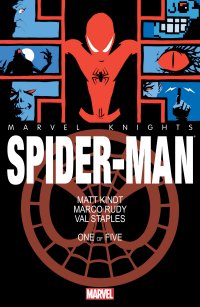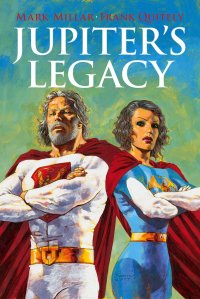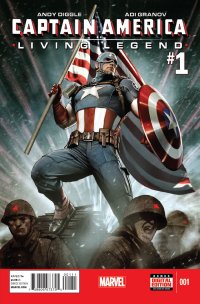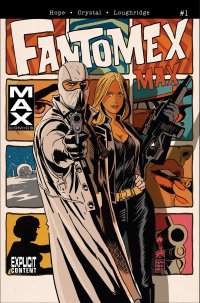Marvel Knights Spider-Man #1 of 5 (Marvel, $3.99)
By Jeb D.
Busy fella Matt Kindt helps relaunch the Marvel line that bears his initials. Marvel Knights is an on again-off again branding used to allow prominent creators to play in the work-for-hire sandbox by telling self-contained stories not mired in continuity porn. The previous iteration of MK Spider-Man featured one of Mark Millar’s less-outrageous but also less-memorable outings; what Kindt and Swamp Thing artist Marco Rudy have come up with here is, for better or worse, unlikely to be characterized in quite the same way.
Peter Parker (remember him?) takes on what he thinks is an ordinary family-photo shooting gig… actually, we can stop right there for a moment, as Kindt’s interior monolog for Parker goes through some slightly tortured hoops to explain why Pete’s doing this (we get it, because story), and the voice never quite rings true. Granted, he’s talking to himself, so we don’t necessarily expect the kind of quippy banter we get when Spidey’s in full battle mode, but there’s a bland neutrality to the writing that doesn’t really hint at much in the way of personality.
Anyway, things don’t go as expected (or do I mean they go exactly as expected?), and Parker’s spider-sense has gone into nuclear mode thanks to some mysterious hallucinations (drug-induced? magic? all part of the game) that confront him with dangerous figures from his past. Just as he finishes a hand-to-hand with Frankenstein’s Monster (the one that isn’t an agent of anything), the face behind the curtain is revealed… and it’s fucking Arcade. A while back, I made my ire with this tiresome character known, and he’s no less tedious this time out (though he looks less like a carnival barker here, and more like early-period Grant Morrison), letting Peter know that he’s doped him, and he’s going to have to “face 99 of the most vile villains on earth” or a bomb goes off killing a bunch of innocents (but Spidey gets credit for the ones he’s already dispatched, so he’s down to something like 95, give or take, over the next four issues). And quite honestly, that seems to be about it: each page or so, Spidey encounters a different bad guy (let’s see, there’s Morbius, Jack O’Lantern, Man-Wolf…) while his internal voice protests over and over again (and over and over again and again) that this can’t be real (” I can’t move… dead? Spider-sense… I’m in… trouble!“). It’s just one issue, but so far it feels like fairly thin gruel for the guy behind Mind MGMT; he may have more detailed or elaborate tricks up his sleeve, but the math (99 /5) doesn’t seem to leave much room for that.
The selling point for this series is going to be the work of Marco Rudy. I don’t know that his “J.H. Williams-turned-up-to-11” layouts would work for your typical Spidey story, but this script demands fractured perception, weird voices echoing around the hero, reality disintegrating, and cute tricks like text boxes reading backwards. In a way, it’s not unlike what you might expect if Steve Ditko had returned to the character with a half-century’s worth of new ideas, and a few tricks borrowed from Dave McKean. The first few pages are a bit rocky; among other things, his huge photo-referenced closeup on Peter Parker’s face reminds me less of Andrew Garfield than some alarming mashup of Ethan Hawke and Bruce Campbell. But once that face gets covered with the mask, and Ruby cuts loose, it’s the kind of psychedelic free-for-all we haven’t seen since the glory days of Englehart and Brunner’s Doctor Strange.
This comic will certainly be a change of pace for Spider-Man readers, regardless of how they feel about the current Superior version*. I don’t know that my grade necessarily reflects a purchase recommendation, so much as it is acknowledging that you really do have to at least sample this at the store, because Ruby’s art has to be seen to be… well, maybe not believed, but at least experienced.
*Speaking of all things Superior, I really try not to review the same books over and over again, but if you’re not yet reading The Superior Foes of Spider-Man, you’re missing out on the most fun Marvel currently has on offer this side of Hawkeye. Issue #4 is out this week.
Rating: 




Out of a Possible 5 Stars
 Grindhouse: Doors Open At Midnight #1 (of 8) (Dark Horse, $3.99)
Grindhouse: Doors Open At Midnight #1 (of 8) (Dark Horse, $3.99)
By Graig Kent
Since the Rodriguez/Tarantino double feature back in 2008, the term “grindhouse” has transcended it street-level descriptor as the place where more… outre films were shown in the 1970’s to instead imply a cinematic subgenre in its own right that takes the aesthetic of those generally low-budget, uncouth productions and recreates it. In modern day it takes effort to make something feel like grindhouse, which almost seems antithetical to the style and spirit of the original cheapo products. The modern version of grindhouse can be found in SyFy originals or The Asylum’s blockbuster but they’re too clean and polished and knowingly terrible, which wasn’t ever what grindhouse sought to do. There’s no irony in grindhouse. There’s sex, violence and a whole lot of gore.
Grindhouse as a subgenre can incorporate almost any other genre into its fold, but universally works best when it incorporate some or all of fantasy, horror and science fiction. Though I question some of the references writer Alex De Campi cites as grindhouse (but then I think I’ve compartmentalized gaillo and samurai films as something more specific outside of grindhouse, which I tend to relate more as American productions) in the backmatter of her new anthology mini-series Grindhouse: Doors Open At Midnight, she certainly understands the genre, which I guess is a must when calling your book “Grindhouse”. Her first tale, “Bee Vixens From Mars” employs all the expected tropes: the backwards small-town setting; the apathetic sheriff and his ass-kicking, hog-riding, one-eye deputy; buxom lipstick lesbians; a gruesome murder scene; violent shrubbery; and bees. Lots of bees.
De Campi and her artist, Chris Peterson get the atmosphere of the genre wholeheartedly, by presenting all of the action action and violence off panel and limiting most of the “effects” required. The biggest sequence is actually the introductory paragraph that sets up the tale, conjuring the image of Mars and its inhabitants without even showing them. Instead it cuts to an opening sequence disconnected yet thematically strung images of bee hives, flowers, masturbation and cats humping before introducing a couple of well endowed women sharing a jar of alien-tainted honey as foreplay. Bees have come from mars,
A grindhouse film plays out its story in earnest. Oh, it knows it’s trash, and generally revels in it, but it does so with honest enthusiasm for doing so. Tarantino has made a career out of turning grindhouse into art house and then into the award winning mainstream, but De Campi and Peterson scale it back to its trashy, low-fi roots and they definitely are reveling in it. Still borrowing inspiration from Tarantino/Rodriguez’s 2008 effort, G:DOAM features posters for currently non-existent grindhouse stories from other artists, like Tim Seely’s “Jackie Lantern: Demon Whore of Halloween”. Much like the cinematic Grindhouse‘s fake trailers for Hobo With A Shotgun or Machete, these fake ads may actually come to reality should this series fare well. It’s a fun proposition at least.
Rating: 




Out of a Possible 5 Stars
Hinterkind #1 (Vertigo, $2.99)
By Adam Prosser
There’s a certain line of thinking that holds that there are no bad premises for a story, just bad executions. I’m not 100% sure I believe that—certainly some premises, whether god or bad, are just so damn tired at this point that they kill any interest I might have in them. But there’s no question that the thing that usually draws me into a story is the moment-to-moment details; well-staged sequences, dialogue that makes the characters live and breathe, and striking, original images or ideas.
Hinterkind manages all this. And yet…it still doesn’t really grab me. And I think part of that is the premise, or at least, the way the premise is deployed. It feels a bit too much of a mash-up of currently popular elements: a post-apocalyptic story a la The Walking Dead fused with an “urban fantasy” element and a whiff of The Hunger Games. (Maybe I’m being a bit reductive with that last one, but when the protagonist is a spunky teenage girl wielding a bow and arrow, and everything else about the story feels so calculated, it’s hard not to be a tad cynical.)
The setting is some time after the human race has been seriously decimated, possibly by a plague, though it’s not clear. Manhattan is home to a colony that’s managed to retain a fair amount of civilization, including a doctor, Asa Monday, whose granddaughter Prosper is the Katniss stand-in protagonist referenced above. The Manhattanites even maintain radio contact with other colonies, though that’s recently hit a snag with the Albany settlement, which has been radio silent for two days as the story opens. We, the audience, know that something fairly horrible has happened to them, but Asa doesn’t, and he’s managed to convince his town council to get together an expedition to find out what’s happened.
Far stranger things are afoot, though, such as Prosper’s friend Angus suddenly…growing a tail. Embarassed and horrified, he decides to light out, and Prosper (forbidden from joining the expedition by her granddad) ends up tagging along. Whatever’s happening to Angus, though, it seems like a very small part of a much weirder occurrence. Apparently, in the absence of human civilization, magical, legendary beings like giants and fairies are starting to re-enter the world again, as Prosper and Angus discover, and they don’t seem to bear humans much goodwill.
I’m not much of a gamer, but isn’t this pretty similar to the idea behind Shadowrun? Well, either way, it most definitely *is* in the Urban Fantasy wheelhouse that Vertigo made its name on in the first place—to the point where this almost feels like the new DC management said, “We need a comic to prove Vertigo is back, something female-friendly, with magic and fairies and shit. Someone get on that.” Don’t get me wrong, the results are reasonably well-executed by writer Ian Edginton and artist Francesco Trifogli (aside from a couple of scenes of clunky dialogue—Prosper feels the need to remind Asa that she’s his granddaughter at one point, for the benefit of the viewing audience) and the issue ends on a compelling cliffhanger. It’s just…I don’t know, something’s missing.
I think it can be summarized by the moment where Prosper looks out from the underbrush at the creature that just killed the lion-tiger hybrids (yes, seriously) that were attacking her, a six-armed, pink-skinned giant. It’s the climax of the issue, and it’s supposed to smack the reader upside the head with the reveal that the world’s just gone even crazier. But the panel is weirdly flat and perfunctory, with little awe or wonder, and accompanied by pointless (and irrelevant) captions; it’s just, “OK, here’s a gigantic pink guy now.” And Prosper’s reaction is a weirdly blasé “Uh oh”.
Fantasy requires a certain sense of atmosphere and wonder to work; I think pop culture has gotten too comfortable with various genre tropes to automatically create a sense of real magic when these supposedly magical creatures pop up in a narrative. As a premise, the whole Urban Fantasy thing has lost a lot of its power; maybe it’s time “fantastical” started to mean “imaginative” again.
Rating: 




Out of a Possible 5 Stars
 Jupiter’s Legacy #3 (Image, 2.99)
Jupiter’s Legacy #3 (Image, 2.99)
By Adam X. Smith
Whilst my oscillation between disdain and curiosity for the work of Grant Morrison continues to be a crutch that I’m not ashamed to make full use of whenever it suits me, it is nothing compared to the loathing, the existential dread I feel in my heart whenever I pick up any comic written in whole or in part by Mark Millar. For all my harping on about Morrison’s sins as a writer, at least his successes and failures excite me enough to have an opinion on his work, for good or ill.
Millar, conversely, seems to only want to be involved in comics as a way of creating his own branding, his own movie franchises, t-shirts and action figures, of setting himself up as the next big innovator whilst bringing virtually nothing new to the ideas table. For every potentially interesting concept he comes up with there are a dozen others that are trite, obnoxious and loaded with the preening smugness of a man who doesn’t care what his audience thinks – he’s making comics for himself and his preening Gen-Y hipster acolytes. If Grant Morrison is trying to be the more mainstream-accessible Alan Moore, Mark Millar is the stunted bastard spawn of Frank Miller and Todd McFarlane, preaching a cult of originality and independence whilst sucking like a parasitic leech on the mainstream’s lifeblood in order to keep in the public eye and to keep selling his loathsome, adolescent tat.
So yeah, Jupiter’s Legacy – a comic that explores the notion of superheroes as the modern day pantheon of Greco-Roman gods. Those who have sat through Grant Morrison’s Supergods (link to my review here) will remember that this was pretty much a recurring theme in that book too, and whilst I could venture a guess as to who ripped off whom*, it makes little difference. The only functional point of reference is that there is a whole bunch of back-story in the first issue and a half explaining how a group of rich Depression-era American know-it-all libertarians essentially went to Skull Island and came back as bona fide superheroes. However, unlike for example Watchmen where the very presence of a SINGLE genuine metahuman completely butterfly-effects the course of the 20th Century, Jupiter’s Legacy gives us nothing of the kind. This is of course hand-waved by the fact Sheldon Sampson aka the Utopian, who fills the Superman role in this universe, is committed to the non-intervention doctrine to the point of indolence, whilst his psionic brother Walt believes that their intervention into politics and the economy would infinitely improve mankind. However, since Big Brother has a terminal case of the lazies, he convinces the Utopian’s dickspurt son Brandon to put the kibosh on the old man so they can rule together – well, mostly Walt, as it turns out. And there’s some stuff about Sheldon’s strung-out daughter Chloe getting knocked up by drug dealer and supposedly reformed supervillain Hutch, but you know what? I’m not even going to pretend this book is anywhere near as interesting as I just made it sound.
For all the crowbarring of topical themes into the narrative, for all the supposed “world-building” that is supposed to have happened by this point, the characters and plot of Legacy are hollow and lustreless and lacking in anything close to genuine humanity, the character development so broad as to be beyond the point of outright parody. Never once in all three issues was I able to successfully remember a single character’s name, personality, agenda or goals as anything other than broad stereotypes, and while the idea of having a superhero pantheon reflect modern society is hardly new, it’s made worse by the fact that Millar doesn’t even pretend that the change of leadership will result in anything new. Every plot-point feels stagey and telegraphed. Even Frank Quitely’s artwork – better than this turgid dreck deserves – cannot salvage the book for me.
In short, Jupiter’s Legacy is not getting a recommendation from this writer. This is not the work of an innovative mind – it’s the cynical grasp for credibility of an egomaniac who thinks he can game the system by selling concepts and movie pitches instead of fleshed out stories, who wants to become the spider squatting at the heart of a media empire yet is fundamentally incapable of doing so without the aid of the major players, and in this case his Millarworld brand’s spiritual successor Image Comics. Mark Millar is not a genius. He is a spoiled brat who wants all the toys to himself, an agent of the status quo masquerading as a maverick. And this comic, more than any of the others he has written, presents us with nothing even close to something worth getting interested in or excited about.
Rating: 




Out of a Possible 5 Stars
*I won’t though, because frankly I don’t care – the book itself points out that the idea is hardly new.
 Savage Wolverine #9 (Marvel, $3.99)
Savage Wolverine #9 (Marvel, $3.99)
By Graig Kent
It’s probably been over 20 years since I last bought a solo Wolverine comic. I like the character enough, but he’s the best at what he does in small doses for me.
That said, I come to Savage Wolverine obviously not for the character, but for the creator, in this case Jock, who never failed to impress on The Losers or Green Arrow: Year One, or Scott Snyder’s Detective Comics run. It’s been a little while since I’ve seen Jock in action but the prospect of him taking on a Wolverine tale was just tantalizing enough for me. I’m not sure why that is, considering all the other artists I admire who have come and gone on Wolverine books over the years, yet still passed over . I guess I just think Jock and Wolverine are a good fit (his covers on Wolverine Max recall Bill Sienkiewicz at his peak).
This arc on Savage Wolverine is Jock’s first as writer/artist, which I braced myself for, expecting something a little rough around the edges. But Jock, writing for himself, writes to his strengths, which is his art, and opens incredibly strong with a three page sequence of Logan crawling along the peak of … some sort of structure hovering in the upper atmosphere, before letting go and burning up on reentry. Woof, healing factor engaged. That’s a beautifully cinematic sequence and something I’ve not seen happen with Wolverine before (again, I admitted to being a less-than-occasional reader, so he could do it every other issue for all I know). I’m sucked in immediately. It’s a simple set-up, executed beautifully, with Logan abandoned on a strange planet, and while the narration seems to indicate that he’s been sent there on a mission, it becomes clear the narrative is not directed at him.
I have no idea where it’s going, and it’s decompressed as all hell, but with purpose, and the purpose is to showcase Jock’s art. Have you ever seen Logan butcher a mite the size of an aircraft carrier? No, you haven’t. But you can thank Jock for providing you the opportunity. This feels part western, part samurai, part post-apocalyptic, but it may be none of those things (or it may be all). We’ll have to see, but it’s definitely worth seeing.
Rating: 




Out of a Possible 5 Stars
 Captain America, Living Legend #1 of 4 (Marvel, $3.99)
Captain America, Living Legend #1 of 4 (Marvel, $3.99)
By Jeb D.
So, wait… this is an Adi Granov comic? And it’s set in WW II? What about the cool, glossy modern hi-tech stuff? Well, there’s both good news and bad news on that front. The good news? This being a Captain America book, the plot spans several decades, and before he’s through, Granov has had the chance to play with moon rockets, space stations, AI machines, and a dangerous new form of molecular energy . Even better news? He handles the scuffed and gritty WW II segment just fine; though his faces still tend to the plastic, his fighting men (Russian, German, American, and a mulit-national fistful of the Howlers) have heroic weight in their stature and grim purpose in their bearing. In fact, from the bitter winter snows of the Bavarian Alps to a secret moon launch to a high-tech interplanetary installation, this is the kind of visually lush and interesting work that made his Iron Man run so memorable.
Oh, the bad news? He’s not doing the remaining three issues.
See, this is the initial issue of what was to have been the Astonishing Captain America series: like the other Astonishing books, the idea was more or less self-contained, out-of-continuity adventures, with big names given the opportunity to take some time developing their stories. I don’t know if the originally-planned 2010 launch (it was, in fact, to be the comic-book debut of Cap’s movie costume) was cancelled due to Granov’s… um… “measured” pacing, but apart from a couple of internal references to the year being 2011, nothing about the story feels particularly out of place in 2013, so it’s particularly disappointing that an additional two years’ delay was evidently still not enough to get Granov to finish the remaining three issues (it appears that they’ll be done by Star Wars artist Augustin Alessio).
And this is doubly disappointing, because Andy Diggle’s got a nice generational story going here: events on the Russian front in the dying (literally) days of WW II’s European theatre are linked to a stealth Russian lunar expedition in the 1960’s,* and reverberate right up to the highest of high tech in the present day (well, of two years ago, as I said). Cap stands tall as a hero, shows his affinity for the burdens of a soldier regardless of uniform, slings a mean shield, demonstrates both strategic and tactical leadership, and saves a life that we know immediately will come back to haunt him. It’s the kind of thing that a book like this should be: action, adventure, a bit of mystery, and apocalyptic stakes; with all that, though, it would have made for a nicer package if Marvel could have kept the same team on it for four stinkin’ issues.
*Completely unrelated, but if this idea sounds interesting, allow me to recommend John Calvin Batchelor’s novel “Peter Nevsky and the True Story of the Russian Moon Landing,” which layers evocative alternate-history world-building across a template borrowed from Dumas’ The Three Musketeers.
Rating: 




Out of a Possible 5 Stars
Fantomex Max #1 (of 4)(Marvel, $3.99)
By Graig Kent
Is it possible to be both pleasantly surprised and disappointed at once?
I remember Fantomex primarily from Morrison’s New X-Men and like him largely because he’s a unabashed riff on the infamous fumetti character Diabolik. I’ve loved Diabolik since the Beastie Boys coopted Mario Bava’s cinematic adaptation of the character into their Body Movin’ music video. Since then, I’ve seen the movie a dozen times and I’ve snagged a few of the digests of the original comics, some still in native Italian and some in badly translated English. Even with that arguably limited (yet somewhat obsessed over) exposure, I think I’ve still been privy to more Diabolik than Fantomex.
If you don’t know Diabolik, he’s a master criminal, perpetrator of such grand heists that he’s captured fame and notoriety, earning the reverence of the people. Also he only steals from bad guys. He enjoys taunting his main rival, Inspector Ginko and he’s got the finest lady in Eva Kant. Fantomex, meanwhile, is a master criminal whose reputation precedes him, because he also only steals from bad guys. He has a feminine artificial intelligence named Eva who fawns at his feet, and his main rival is also his main object of desire, the shapely special agent, Rhona Flemyng. (at least that’s how he’s presented here).
I can’t speak to how Fantomex has been portrayed elsewhere over the years, but it’s so evident to me that writer Andrew Hope is aware of Fantomex’s comic book inspiration and is more than certainly playing into that here. Fantomex MAXis a romp, a criminal versus criminal clash with Flemying in the center, thus a little romance and titillation is thrown into the mix. It’s part of Marvel’s MAX imprint, intended for explicit content, but beyond a few F-bombs and some excessively cartoony violence, it’s relatively harmless, which, actually, is kind of disappointing. Hope fleshes out his story with glibness and Shawn Crystal’s exaggerated style extends the “fun!” feeling, but takes any punch out of the story and the “MAX” conceit. Little of the content feels explicit here. If Fantomex were to distinguish himself from Diabolik hitting heavier on the sex and violence may have been in order, but obviously that’s not the intent.
Crystal and colorist Lee Laughridge play into the old-school-comics/MAX juxtaposition even further by throwing around a lot of colored zip-a-tone lending the book a very distinctive and appealing look, but again one I’m not sure fits the MAX sensibility. It may be that the series is just aping Deadpool MAX sans the ultraviolence, but it just doesn’t seem to fit.
You can sense the conflict I’m having. On the one hand, I appreciate the attempt at a modern twist on Diabolik, and I’m sure by being outside Marvel continuity it aides Hope’s vision, but on the other hand, here was a chance to do and steamier, more seductive pop-art version of Diabolik, one which Francesco Francavilla’s spot on cover suggests, but instead feels like an Archer knock-off, only more cartoony.
Rating: 




Out of a Possible 5 Stars